Philippine sausages, or longganisa, are a beloved staple in Filipino cuisine, offering a flavorful blend of sweet, savory, and tangy notes. Made with ground pork seasoned with garlic, vinegar, soy sauce, and various spices, longganisa comes in a variety of regional styles, each boasting its own unique flavor profile. From the garlicky sweetness of Vigan longganisa to the tangy and spicy notes of Chorizo de Cebu, these sausages are typically fried until golden brown and served with garlic fried rice and eggs, creating a delicious and satisfying breakfast or any-time-of-the-day meal that delights Filipino palates nationwide.
Longaniza

Longaniza is a popular dish in the Philippines that showcases the country's diverse culinary influences. This sausage dish is often made with a combination of ground pork, garlic, vinegar, soy sauce, and various spices, creating a unique and flavorful taste. Longaniza comes in different regional variations, with each province putting its own twist on the recipe. In the northern regions, the sausages are typically sweet and garlicky, while in the southern parts, they are usually spicy and tangy. The sausages are usually shaped into long, thin links and are often grilled or pan-fried until they are slightly caramelized and crispy on the outside. Longaniza is a versatile dish that can be enjoyed in various ways. It is commonly served with garlic fried rice and eggs for breakfast, or as a filling for sandwiches or wraps. It can also be used as an ingredient in other Filipino dishes, such as spaghetti or sinigang.
Embutido

Embutido is a classic Filipino dish that showcases the artistry and flavor of Philippine sausages. This delectable dish is made by combining ground pork, breadcrumbs, eggs, and various spices, resulting in a flavorful and succulent sausage roll. To prepare embutido, the mixture is spread on a sheet of aluminum foil or banana leaf and rolled into a log-like shape. It is then steamed or baked until cooked through. Once cooled, the embutido is sliced into thick rounds, revealing the vibrant colors and delicious aroma of the dish. Embutido is often served as a main course during special occasions and festivities, as it is not only tasty but also visually appealing. The dish is commonly enjoyed with a side of tomato ketchup or sweet chili sauce, which complements the savory flavors of the sausages.
Chorizo de Bilbao
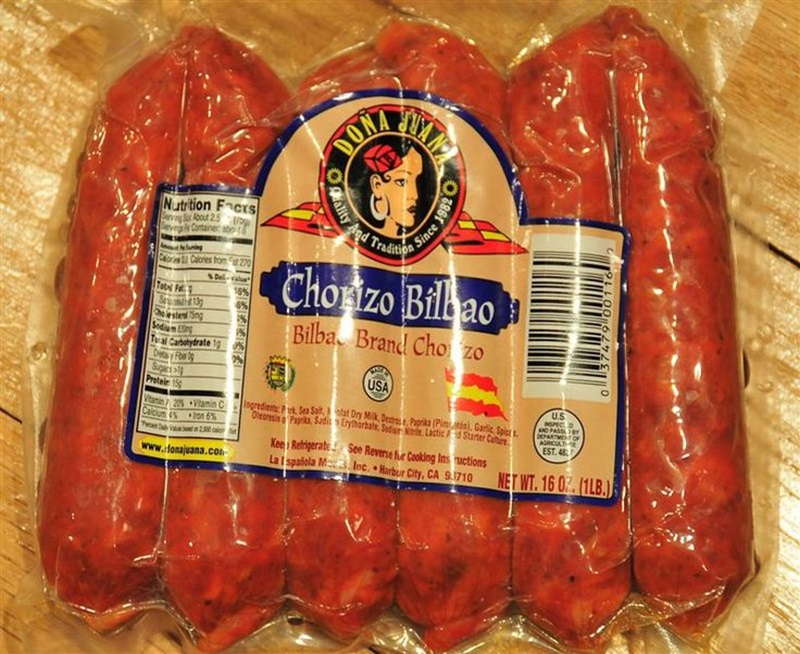
Chorizo de Bilbao is a popular Filipino dish that showcases the rich culinary heritage of the Philippines. Chorizo de Bilbao is a flavorful and vibrant sausage originating from the Basque region of Spain. The Chorizo de Bilbao sausages are made from coarsely ground pork meat, seasoned with a blend of spices such as paprika, garlic, and black pepper. The sausage is then smoked to enhance its unique taste and aroma. The result is a sausage with a deep, smoky flavor that adds a delightful kick to any dish. In the Philippines, Chorizo de Bilbao is commonly used in a variety of recipes. It can be sliced and cooked with rice to make a flavorful fried rice dish called Chorizo Rice. It is also a popular ingredient in stews, such as the famous Filipino dish called Cocido, which is a hearty meat and vegetable stew. Whether as a main ingredient or a flavor enhancer, Chorizo de Bilbao adds a distinct taste to Filipino dishes.
Chorizo de Cebu

Chorizo de Cebu is a popular dish in the Philippines, specifically in the province of Cebu. It is a type of sausage that is known for its distinct flavor and vibrant red color. The sausages are made from ground pork that is seasoned with a combination of spices such as garlic, paprika, vinegar, and various local herbs. One of the key ingredients that sets Chorizo de Cebu apart is the addition of annatto seeds, which give the sausages their vibrant red hue. The mixture is then stuffed into natural casings and left to cure for a period of time, allowing the flavors to meld together and develop. Once cured, the sausages are typically grilled or fried until they are cooked through and slightly charred on the outside. Chorizo de Cebu is often served as a main dish or used as an ingredient in various Filipino recipes.
Vigan longganisa

Vigan longganisa is a type of sausage made from ground pork, flavored with local spices and vinegar, and stuffed into natural casings. It is quite popular in the province of Ilocos Sur in the Philippines. What sets Vigan longganisa apart is its distinct taste and texture. The combination of garlic, vinegar, and various spices gives it a unique and flavorful profile. The sausages are usually marinated for a few hours to allow the flavors to combine together before they are cooked. When cooked, Vigan longganisa has a slightly sweet and tangy taste with a hint of garlic. The casings become crispy and the inside remains juicy and tender. It is often served with garlic fried rice and a side of vinegar for dipping. Vigan longganisa is not just a treat for the taste buds but also a cultural experience as it represents the culinary heritage of the Ilocanos.
Lucban longganisa
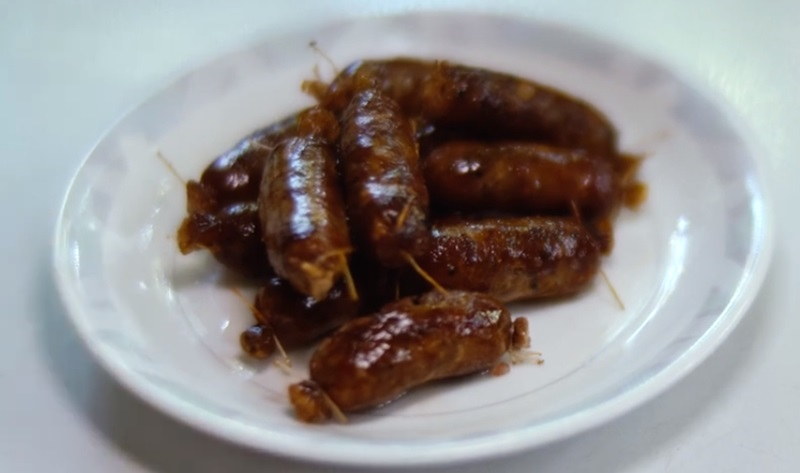
Lucban longganisa is a popular Filipino sausage dish originating from the town of Lucban in Quezon province, Philippines. It is known for its distinct flavor and unique preparation method. The sausage is made from ground pork, which is seasoned with a combination of garlic, vinegar, salt, pepper, and other spices. What sets Lucban longganisa apart from other sausages is the addition of native ingredients such as fermented shrimp paste and dried oregano, giving it a distinct and savory taste. The sausages are typically shaped into small, plump links and are traditionally marinated for at least 12 hours to allow the flavors to meld together. They are then either pan-fried or grilled to perfection, resulting in a slightly charred and crispy exterior with a juicy and flavorful interior. Lucban longganisa is often enjoyed for breakfast, paired with garlic fried rice and a sunny-side-up egg.
Cabanatuan longganisa

Cabanatuan longganisa is a popular Filipino sausage hailing from the city of Cabanatuan in the Philippines. This delicious delicacy is made from ground pork, flavored with a combination of garlic, vinegar, and spices. The mixture is then stuffed into hog casings and formed into small sausages. What sets Cabanatuan longganisa apart from other sausages is its distinct tangy and garlicky flavor. The vinegar adds a unique zing to the dish, while the garlic provides a savory kick. To prepare Cabanatuan longganisa, it is usually fried until golden brown and served with steamed rice and a side of vinegar dipping sauce. The sausages are slightly sweet, juicy, and bursting with flavors, making it a favorite breakfast or lunch option for many Filipinos.
Chorizo de Macao

Chorizo de Macao is a popular Filipino sausage that showcases the country's love for sausages. It is a unique and flavorful dish that originated from the Portuguese-Chinese community in Macao, China, and was later introduced to the Philippines. This dish features small, plump sausages made from a mixture of ground pork, garlic, paprika, vinegar, and various spices. The sausages are typically marinated for hours to allow the flavors to mix together before they are either grilled, fried, or stewed. Chorizo de Macao is known for its distinctive taste, characterized by a perfect balance of savory, sweet, and tangy flavors. The sausages have a slightly smoky and garlicky aroma, and their vibrant red color adds a visually appealing element to the dish. This flavorful sausage dish is incredibly versatile and can be enjoyed in various ways. It can be served as an appetizer, accompanied by rice or bread, or incorporated into other dishes such as pasta, stews, or fried rice.
Pinuneg
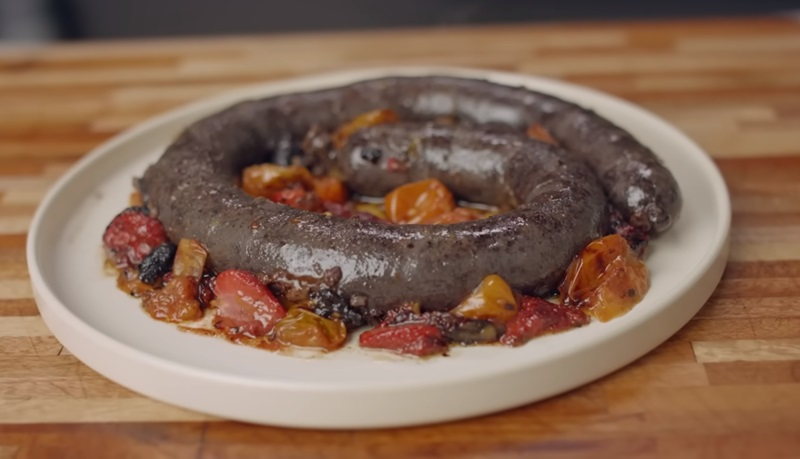
Pinuneg is a Filipino blood sausage, tracing its origin to Luzon island. These sausages are made from a combination of pig blood, ground pork, pork fat, red onions, ginger, and garlic, resulting in a flavorful and savory taste. The sausages are typically smoked or grilled to perfection, giving them a smoky and slightly charred exterior. To prepare Pinuneg, the sausages are first cooked until they are tender and juicy. They are then sliced into bite-sized pieces and served alongside steamed rice or as a filling for sandwiches or wraps. The dish is often enjoyed with a side of spicy vinegar or soy sauce for added flavor. Pinuneg is a popular dish in the northern regions of the Philippines, particularly in the provinces of Ilocos and Cagayan.
Alaminos Longganisa
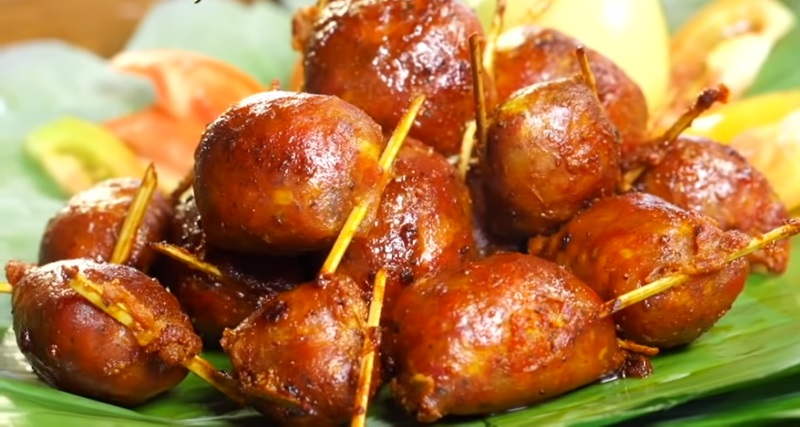
Alaminos longganisa is a popular Filipino sausage known for its distinct flavor and unique combination of ingredients. Originating from the city of Alaminos in the province of Pangasinan, this sausage dish is a local delicacy that has gained popularity throughout the Philippines. Alaminos longganisa is made from ground pork mixed with various spices and seasonings, including garlic, brown sugar, soy sauce, coarse salt, vinegar, and pepper. What sets it apart from other sausages is the addition of fermented shrimp paste, giving it a tangy and slightly salty taste. The mixture is then stuffed into hog casings and left to cure for a few hours or overnight to develop its flavors. When cooked, Alaminos longganisa is typically fried until it becomes crispy and golden brown. It is often served with steamed rice, sliced tomatoes, and salted eggs, creating a hearty and satisfying meal. The combination of the slightly sour and savory flavors of the longganisa, paired with the freshness of the tomatoes and richness of the salted eggs, creates a delightful culinary experience.
Calumpit longganisa
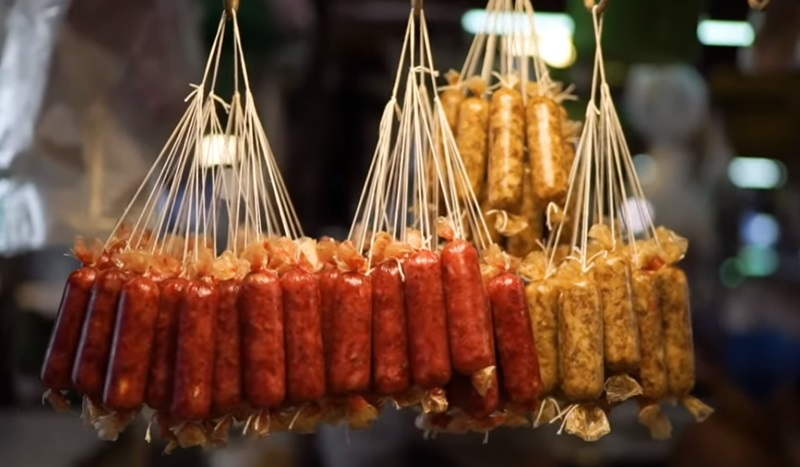
Calumpit longganisa is a popular Filipino pork sausage originating from Calumpit, Bulacan in the Philippines. It is made from ground pork, garlic, vinegar, and a unique blend of spices that give it its distinct flavor. The sausages are traditionally handcrafted and cured for a few days to enhance the flavors. Calumpit longganisa is characterized by its small size and reddish-brown color. It has a sweet and savory taste with a hint of tanginess from the vinegar. The texture is slightly firm and juicy, making it a delightful treat to bite into. This dish is commonly enjoyed for breakfast, paired with steamed rice and fried eggs. It can also be used as a filling for sandwiches or as an ingredient in other Filipino dishes like pancit or sinangag. The sausages can be fried, grilled, or even cooked in a stew, offering versatility in preparation methods.
Pampanga longganisa

Pampanga longganisa is a popular Filipino sausage hailing from the province of Pampanga, known as the culinary capital of the Philippines. This delectable dish is made with ground pork, garlic, black pepper, brown sugar, vinegar, and various spices, giving it a distinct savory and slightly tangy flavor. The sausages are traditionally handcrafted using natural casings, which contribute to their juicy and succulent texture. The mixture is typically marinated overnight to allow the flavors to meld together before being stuffed into the casings. Pampanga longganisa is usually sold in long links, and it can be grilled, pan-fried, or even boiled. One of the distinguishing characteristics of Pampanga longganisa is its vibrant red color, which is achieved by adding achuete or annatto seeds to the marinade. This not only enhances the visual appeal of the dish but also adds a subtle earthy taste. Pampanga longganisa is often enjoyed for breakfast, served alongside garlic rice, fried eggs, and a side of vinegar for dipping.
Chicken longganisa

Chicken longganisa is a popular sausage in the Philippines, known for its delicious and savory flavors. Made from ground chicken meat, this sausage is seasoned with a blend of spices and herbs such as garlic, ginger, soy sauce, and vinegar. The mixture is then formed into small sausages and typically marinated overnight to enhance the flavors. When cooked, chicken longganisa has a slightly sweet and tangy taste, with a hint of smokiness. The sausages are usually pan-fried until they are golden brown and caramelized, giving them a crispy and juicy texture. They are often enjoyed for breakfast or as a filling for sandwiches and wraps. Chicken longganisa is a versatile dish that can be served with a variety of accompaniments. It pairs well with steamed rice, fried eggs, and a side of fresh tomatoes or atchara (pickled papaya).
Longganisa de Guinobatan
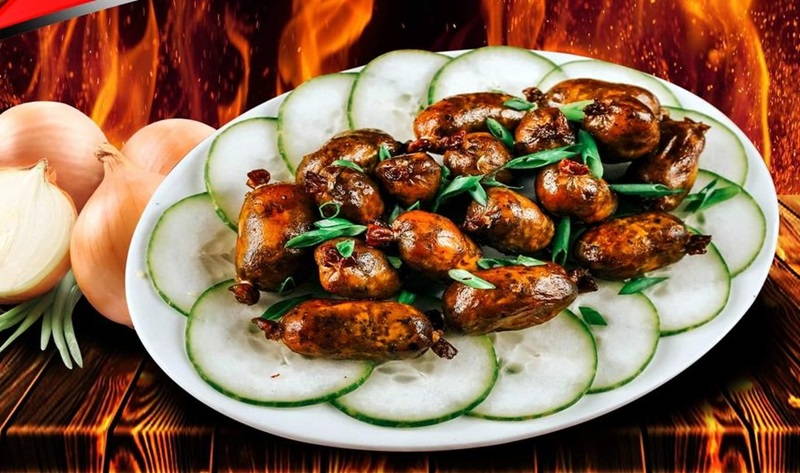
Longganisa de Guinobatan is a popular Philippine sausage that originated from the town of Guinobatan in the province of Albay. It is a delicious and flavorful breakfast staple that is loved by Filipinos all over the country. It is made from ground pork mixed with a variety of local ingredients such as garlic, vinegar, soy sauce, sugar, and various spices. The mixture is then stuffed into natural casings, giving it its distinct shape and texture. Longganisa de Guinobatan is known for its sweet and savory taste, with a hint of tanginess from the vinegar and soy sauce. To cook Longganisa de Guinobatan, it is usually pan-fried until it is nicely browned and cooked through. It is often served with a side of garlic fried rice and a fried egg, making it a complete and satisfying meal.
Fish longganisa

Fish longganisa is a type of sausage made from minced fish, combined with various spices and seasonings, and then encased in a natural casing. The fish used in this dish can vary, but commonly include bangus (milkfish) or galunggong (mackerel scad). This gives the sausage a distinct seafood flavor that is both savory and slightly sweet. The addition of local herbs and spices, such as garlic, ginger, and black pepper, further enhances the taste profile, creating a burst of flavors in every bite. Fish longganisa can be enjoyed in various ways. They can be pan-fried until golden brown and served for breakfast alongside garlic fried rice and a sunny-side-up egg. They can also be grilled or barbecued, providing a smoky and charred flavor that complements the natural sweetness of the fish.
Tuguegarao longganisa
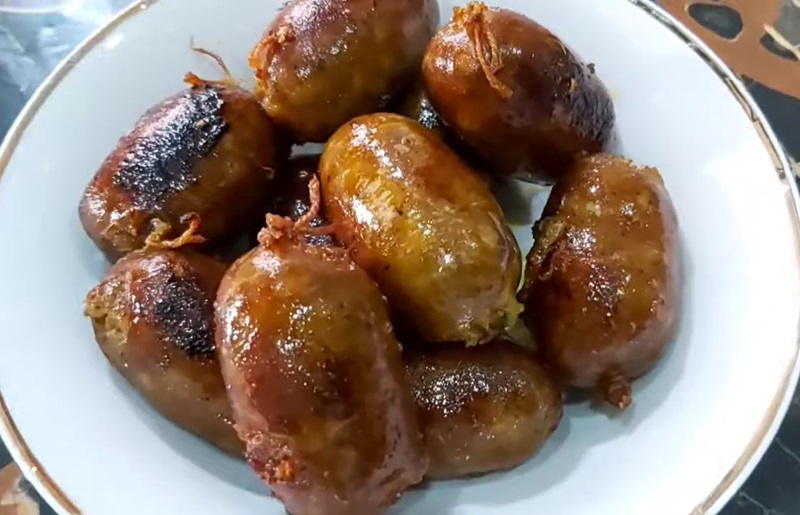
Tuguegarao longganisa is a popular Filipino sausage that has its origins in the province of Cagayan in the northern part of the Philippines. It is known for its distinct flavor and unique combination of ingredients. Made from ground pork, Tuguegarao longganisa is seasoned with a mixture of garlic, vinegar, soy sauce, salt, and various spices, giving it a savory and slightly tangy taste. What sets Tuguegarao longganisa apart from other sausages is its distinctive shape. It is traditionally made into long, thin links that are coiled into small circles, resembling a snail's shell. This shape not only makes it visually appealing but also enhances its flavor as the spices are evenly distributed throughout the meat. Tuguegarao longganisa is typically served for breakfast, paired with garlic rice and fried eggs. It can also be enjoyed any time of the day, either grilled, pan-fried, or even deep-fried.
Chorizo Negrense

Chorizo Negrense is a delicious and flavorful Filipino sausage originating from the province of Negros in the Philippines.This sausage showcases the unique flavors and culinary traditions of the region. The star of Chorizo Negrense is the native Filipino sausage called chorizo. Made from a combination of ground pork, spices, and vinegar, these sausages are known for their bold and savory taste. The sausages are typically marinated in a mixture of soy sauce, vinegar, garlic, and spices, allowing the flavors to infuse and develop. Once marinated, the chorizo sausages are pan-fried until they are cooked through and slightly caramelized, resulting in a deliciously smoky and slightly sweet taste. The dish is often served with a side of steamed rice, making it a hearty and satisfying meal.
Baguio longganisa

Baguio longganisa is a mouthwatering Filipino sausage that originated in the city of Baguio in the Philippines. It is a popular delicacy known for its distinct taste and aroma. Made from ground pork, garlic, vinegar, and various spices, this sausage is packed with flavor and has a slightly sweet and tangy taste. The preparation of Baguio longganisa involves marinating the ground pork in a mixture of vinegar, garlic, and spices. After marinating overnight, the mixture is then stuffed into sausage casings and left to cure for a few hours. The sausages are usually pan-fried until they are golden brown and cooked through. Baguio longganisa is often served for breakfast, accompanied by fried rice, eggs, and vinegar dipping sauce. Its unique flavor profile makes it a favorite among locals and visitors alike.
Guagua longganisa

Guagua longganisa is a popular Filipino sausage that originated in the town of Guagua, Pampanga in the Philippines. It is a type of sausage characterized by its sweet and savory flavors. The main ingredients used in making Guagua longganisa are ground pork, garlic, vinegar, soy sauce, and various spices. The mixture is then stuffed into hog casings and shaped into small, bite-sized links. What sets Guagua longganisa apart from other sausages is its distinct blend of flavors. The sweetness comes from the addition of sugar or brown sugar, while the savory taste is enhanced by the use of soy sauce and vinegar. The garlic adds a subtle yet aromatic kick to the dish. Traditionally, Guagua longganisa is fried until brown and served with steamed rice, sliced tomatoes, and salted eggs. It is often enjoyed as a breakfast or brunch dish, preferably paired with vinegar or spicy vinegar dip for added tanginess.







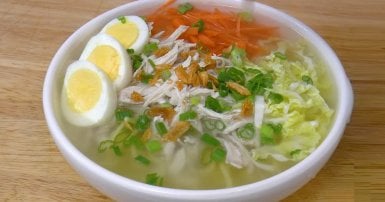

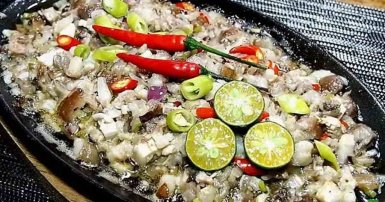



-1709813013.jpg)


